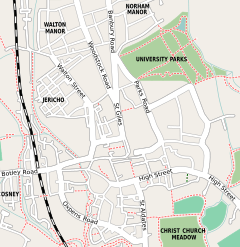Charsley's Hall facts for kids
Quick facts for kids Charsley's Hall |
|
|---|---|
| University | University of Oxford |
| Location | Parks Road |
| Coordinates | 51°45′29″N 1°15′23″W / 51.758031°N 1.256501°W |
| Latin name | Aula Privata Magistri Charsley |
| Established | 1862 |
| Closed | 1891, then became Marcon's Hall (1892–1918) |
| Named for | William Henry Charsley (Master) |
| Master | William Henry Charsley |
| Map | |
Charsley's Hall was a unique place for students at the famous University of Oxford in England. It was known as a "private hall." This meant it was run by an individual person, not by the university itself like the bigger colleges. After 1891, it changed its name and became known as Marcon's Hall.
Contents
What Was Charsley's Hall?
Charsley's Hall was a special kind of student residence at the University of Oxford. Unlike the main colleges, it was a "private hall." This meant it was managed by a private individual, not directly by the university.
How It Started
The hall was opened in 1862 by a man named William Henry Charsley. He used to be a part of Christ Church, another Oxford college. The university had passed a rule in 1855 called De Aulis Privatis (which means "On private halls"). This rule allowed any experienced teacher or university member over 28 years old to open their own private hall if they got permission.
Charsley's Hall was located at 10 Parks Road in Oxford. This spot was near the corner of Museum Road, right across from the Oxford University Museum. The building itself was a red-brick Victorian house. It was designed by Charles Buckeridge and built in the same year the hall opened, 1862. In 1871, records show that nine people were living there.
Student Life and Costs
Charsley's Hall did not have official tuition fees that everyone paid. Instead, students chose their own teachers and arranged how to pay them. Generally, the costs to study there were higher than at other places in the university.
Even with higher costs, the hall was quite popular. In 1883, someone wrote that Mr. Charsley was very successful with his hall. They noted that students who came to Charsley's often had more money than those who were trying to save money at the university.
By 1889, some people saw moving to Charsley's as a way for students to get around certain rules of the main colleges. The Oxford Magazine even thought the hall might close soon. They mentioned that life at a private hall like Charsley's was very different from other places.
Charsley's Hall is even mentioned in a funny poem from the 1870s called The Lay of the First Minstrel. This poem was a parody, which means it made fun of or imitated the style of famous writer Sir Walter Scott. The poem included lines about Charsley's Hall.
The End of Charsley's
Between 1889 and 1890, Charsley's Hall had 47 undergraduate students. At that time, there was only one other private hall, Turrell's, which had just seven students.
It seems that William Henry Charsley, the Master of the hall, also ran a school for younger boys. This might explain why some students started at Charsley's at a very young age.
By the end of 1891, Charsley's Hall closed its doors. However, it didn't stay closed for long. In 1892, Charles Abdy Marcon reopened it. Marcon himself had been a student at Charsley's. The hall was then renamed Marcon's Hall.
Whitaker's Almanack, a well-known British reference book, listed three private halls at Oxford in 1897: Marcon's, Turrell's, and Grindle's. Marcon's Hall continued under that name until Charles A. Marcon retired in 1918.
Notable People
Several interesting people were connected to Charsley's Hall:
- William Morfill taught philosophy and modern history at the hall from 1865 to 1869.
- Edward John Payne finished his first university degree at Charsley's in 1871.
- Charles Abdy Marcon earned his first degree from Charsley's in 1878. He later took over from William H. Charsley as the Master in 1891, reopening it as Marcon's Hall.


